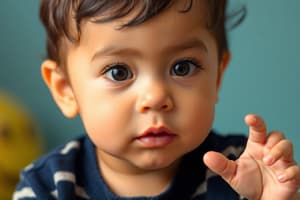Podcast
Questions and Answers
What method is used to measure fetal visual perception in research?
What method is used to measure fetal visual perception in research?
- Sucking
- Eye tracking (correct)
- Heart rate
- Head turning
At what gestational age can premature infants track a laterally moving target?
At what gestational age can premature infants track a laterally moving target?
- 4 months
- 26 weeks
- 31 weeks (correct)
- 18 weeks
What is the approximate acuity of newborn visual perception compared to adults?
What is the approximate acuity of newborn visual perception compared to adults?
- 60 times worse than adults
- Approximately the same as adults
- 30 times worse than adults (correct)
- Better than adults
What is the focal length of newborn visual perception fixed at?
What is the focal length of newborn visual perception fixed at?
At what age do newborns develop stereoscopic depth perception?
At what age do newborns develop stereoscopic depth perception?
What is revealed by ultrasound studies regarding fetal visual perception?
What is revealed by ultrasound studies regarding fetal visual perception?
Which method involves presenting two stimuli simultaneously to measure infant preferences?
Which method involves presenting two stimuli simultaneously to measure infant preferences?
What is a limitation of newborn visual perception?
What is a limitation of newborn visual perception?
At what age do neural pathways from each eye project to the same site in V1 before being fully developed?
At what age do neural pathways from each eye project to the same site in V1 before being fully developed?
What is the main period during which visual acuity improves after birth?
What is the main period during which visual acuity improves after birth?
According to Maurer, Lewis, Brent & Levin, to what extent is acuity a maturational process?
According to Maurer, Lewis, Brent & Levin, to what extent is acuity a maturational process?
According to Fants 1961, at what age do infants start to show a preference for faces?
According to Fants 1961, at what age do infants start to show a preference for faces?
Based on Maurer & Barrera 1981, at what age do infants prefer 'real' faces over other stimuli?
Based on Maurer & Barrera 1981, at what age do infants prefer 'real' faces over other stimuli?
According to Reid et al 2017, at what gestational age does the foetus preferentially turn towards face-like stimuli?
According to Reid et al 2017, at what gestational age does the foetus preferentially turn towards face-like stimuli?
At what age can newborns recognize their mother's face from an unfamiliar female face, as per Pascalis et al 1995?
At what age can newborns recognize their mother's face from an unfamiliar female face, as per Pascalis et al 1995?
According to Slater et al 2000, are newborns sensitive to internal facial features?
According to Slater et al 2000, are newborns sensitive to internal facial features?
According to Gibson & Walk 1960, at what age can most infants perceive depth?
According to Gibson & Walk 1960, at what age can most infants perceive depth?
What frequencies are newborns most responsive to, according to studies of newborn auditory perception?
What frequencies are newborns most responsive to, according to studies of newborn auditory perception?
According to DeCasper & Fifer 1980, what type of voice do newborns prefer to listen to?
According to DeCasper & Fifer 1980, what type of voice do newborns prefer to listen to?
Flashcards
Fetal visual perception measurement
Fetal visual perception measurement
Eye tracking is used to study the visual perception of fetuses.
Premature infant eye tracking
Premature infant eye tracking
Premature infants can track moving targets at 31 weeks gestation.
Newborn visual acuity
Newborn visual acuity
Newborn visual acuity is approximately 30 times worse than adults.
Newborn focal length
Newborn focal length
Signup and view all the flashcards
Stereoscopic depth perception
Stereoscopic depth perception
Signup and view all the flashcards
Ultrasound and fetal vision
Ultrasound and fetal vision
Signup and view all the flashcards
Preference method
Preference method
Signup and view all the flashcards
Newborn visual limitation
Newborn visual limitation
Signup and view all the flashcards
Neural pathway development
Neural pathway development
Signup and view all the flashcards
Visual acuity improvement
Visual acuity improvement
Signup and view all the flashcards
Acuity maturation
Acuity maturation
Signup and view all the flashcards
Face preference, age
Face preference, age
Signup and view all the flashcards
Real face preference
Real face preference
Signup and view all the flashcards
Prenatal face preference
Prenatal face preference
Signup and view all the flashcards
Mother's face recognition
Mother's face recognition
Signup and view all the flashcards
Internal facial features
Internal facial features
Signup and view all the flashcards
Depth perception age
Depth perception age
Signup and view all the flashcards
Newborn auditory response
Newborn auditory response
Signup and view all the flashcards
Mother's voice infant preference
Mother's voice infant preference
Signup and view all the flashcards




